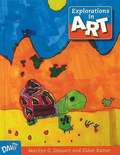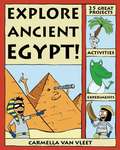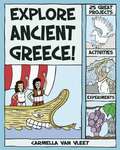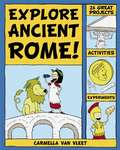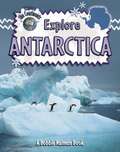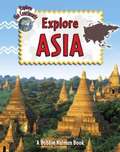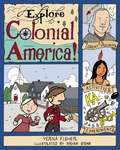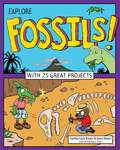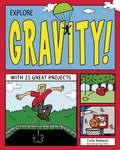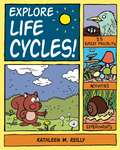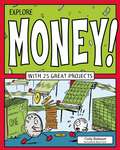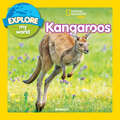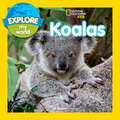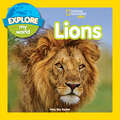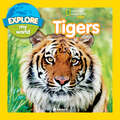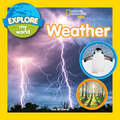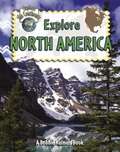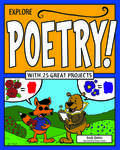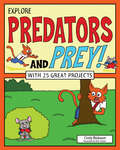- Table View
- List View
Exploding Ants
by Joanne SettelA wasp lays its eggs under a caterpillar's skin so that its young can eat the caterpillar's guts as they grow. A young head louse makes its home on a human hair and feasts on human blood. Frogs use their eyeballs to help swallow their food. From small worms that live in a dog's nose mucus to exploding ants to regurgitating mother gulls, this book tells of the unusual ways animals find food, shelter, and safety in the natural world. If animals all ate the same things and lived in the same places, it would be impossible for all of them to survive. So they specialize. Some animals eat the bits that others leave behind, such as skin and mucus. They find all kinds of unusual places to shelter, including the cracks and holes in another creature's skin or its internal organs. They use their own bodies to protect themselves from predators by imitating unsavory items such as bird droppings and even by blowing up. These habits that may seem disgusting to us are wonderful adaptations that make it possible for a great variety of creatures to live and thrive on Earth. Read about them and marvel at the amazing ways animals adapt to the natural world.
Exploration And Conquest: 1500-1620
by Giulio Maestro Betsy MaestroChristopher Columbus was not the first to discover the Americas, but his voyages led to European exploration of the New World. Rich in resources and natural beauty, the Americas were irresistible to gold-hungry conquistadors. The newcomers gave little thought to those who had called the lands their home, and exploration soon came to signify conquest. The New World -- and the lives of its inhabitants -- would be changed forever.
Explorations in ART, Grade 2
by Eldon Katter Marilyn G. StewartTHEMES: Each Student Book includes six units, each organised around a universal theme relevant to students' lives. These themes foster meaningful connections to artworks across time and place. Elements and principles are embedded throughout each unit to ensure continual application and understanding. STRANDS: Each unit theme is organised into three teaching and learning strands that explore specific aspects of the unit theme. Each strand includes two concept lessons -- each with a studio -- and an extended Studio Exploration with hands-on, cumulative reinforcement of the two previous concept lessons.
Explore Ancient Egypt!
by Carmella Van Vleet Alex KimPyramids, mummies, amulets, temples, and pharaohs- Explore Ancient Egypt! brings this fascinating civilization to young readers ages 6-9 with 25 hands-on projects, activities, and games. Kids learn about ancient Egyptian homes, food, money, toys, games, makeup, clothes, kings, mummies, and more. Projects are easy to follow and require primarily common household products and very little adult supervision.Activities range from making a scarab necklace to writing in ancient Egyptian hieroglyphs and making King Tut sandals. By combining a hands-on element with riddles, jokes, facts, and comic cartoons, kids Explore Ancient Egypt! in this accessible introduction to an incredible, ancient world.
Explore Ancient Greece!
by Carmella Van Vleet Alex KimInvestigate the fascinating civilization of ancient Greece through 25 hands-on projects and activities for young readers ages 6-9. Kids learn about ancient Greek homes, food, playtime, clothing, conquests, arts and entertainment, gods, and more. Activities range from fashioning a model oil lamp from clay to building a courtyard column and constructing a flipbook sailing ship. By combining a hands-on element with riddles, jokes, fun facts, and comic cartoons, kids Explore Ancient Greece! and develop an understanding of how this ancient civilization still influences our modern world.
Explore Ancient Rome!
by Carmella Van Vleet Alex KimInvestigate the fascinating civilization of ancient Rome through 25 hands-on projects and activities for young readers ages 6-9. Kids learn about ancient Roman homes, food, playtime, clothing, conquests, gods, entertainment, and more. Activities range from creating an amphora and making a tunic to baking bread and hosting a Roman feast. By combining a hands-on element with riddles, jokes, fun facts, and comic cartoons, kids Explore Ancient Rome! and develop an understanding of how this ancient civilization laid the foundation of our modern world.
Explore Antarctica (Explore the Continents)
by Bobbie Kalman Rebecca SjongerThis book explores Antarctica--the freezing continent in the south pole: its geography inhabitants and other interesting facts.
Explore Asia (Explore the Continents)
by Bobbie Kalman Rebecca SjongerThis book explores Asia--the biggest continent in the world. It also talks about its geography, people, famous tourist places and other interesting facts.
Explore Colonial America!
by Verna Fisher Bryan StoneIn Explore Colonial America!, kids ages 6-9 learn about America's earliest days as European settlements, and how the colonists managed to survive, build thriving colonies, and eventually challenge England for independence.How did the colonists build homes, feed and clothe themselves, and get along with the Native Americans who were already here? This accessible introduction to the colonial period teaches young children about the daily lives of ordinary colonists and offers fascinating stories about those who helped shape the emerging nation. Activities range from creating a ship out of a bar of soap and building a log home out of graham crackers and pretzels to making a wampum necklace. Projects are easy-to-follow, require minimal adult supervision, and use primarily common household products and recycled supplies.By combining a hands-on element with riddles, jokes, fun facts, and comic cartoons, kids Explore Colonial America!, and have a great time discovering our nation's founding years.
Explore Fossils!
by Cynthia Light Brown Grace BrownIn Explore Fossils! With 25 Great Projects, readers can expand their dinosaur obsessions into learning opportunities that take them beyond Triceratops, Stegosaurus, and even Tyrannosaurus rex to other animals, plants, and microbes that lived long before humans. Explore Fossils! introduces young readers to the history of life on Earth as revealed by fossils. Kids learn how fossils form and about the different types of fossils and the world of long ago--its landscape and the plants and animals that lived then. Scientists use radiometric dating to test fossils to discover when they were made, what organisms made them, what those organisms used for energy, what killed them, and a whole lot of other information. All from rocks! That's a lot of information stored under our feet. Activities include creating plaster fossils, using popcorn to illustrate radiometric dating, and exploring what might have caused mass extinctions by making a lava flow and simulating an asteroid impact. By studying the past, not only do students meet amazing plants and animals, they are also encouraged to consider their own role in geological time to make thoughtful hypotheses about the future.
Explore Gravity!
by Bryan Stone Cindy BlobaumHow can something that grounds us and keeps us here on this earth be so invisible and mysterious? We're not talking about anything abstract and undetectable. We're talking about GRAVITY! Gravity is a force that affects everyone and everything. Gravity is something we can easily understand, even kids, especially if they have the right tools to teach them.Explore Gravity! With 25 Great Projects will introduce kids ages 6-9 to the basics of gravity, including concepts of matter, attraction, and gravitational pull. Projects include creating a working model of a scale to learn what "weight" really means and how it's affected by gravity. By playing with various weights to make a marvelous mobile, readers learn about the center of balance and how martial artists use this knowledge to throw their weight around. All the projects in this book are easy to follow, require little adult supervision, and use commonly found household products, many from the recycling box! The fun facts, trivia, jokes, comics, and hands-on activities will help kids discover the captivating science of gravity. Furthermore, the informational text and hands-on activities will excite kids about STEM, the interrelated fields of science, technology, engineering, and math.
Explore Life Cycles!
by Kathleen M. Reilly Bryan StoneExplore Life Cycles! takes kids on an amazing journey, where they'll learn about the changes plants and animals experience throughout their lives. Kids ages 6-9 will discover what happens inside those magical cocoons to transform a caterpillar into a butterfly. They'll explore how frogs breathe underwater as tadpoles, then use lungs as an adult. Explore Life Cycles! will examine how plants and animals are born, develop, and live their lives.Activities range from creating edible life cycles of insects to making a mealworm nursery. Using an eye-catching combination of cartoons, fun facts, and exciting projects, Explore Life Cycles! will bring the mysteries of life right into kids' hands.
Explore Money!
by Bryan Stone Cindy BlobaumIn Explore Money! With 25 Great Projects, money is more than something to earn, save, and spend. It's an opportunity to explore history, art, science, economics, and math! While checking out the change in their pockets and bills from their banks, young readers search for hidden treasures, learn how money can multiply, and see how countries keep their currency secure. Very large and very small numbers take on a new relevance when seen through the lens of money. Using familiar materials found in the home or classroom, young readers explore the cultural aspect of money as well as its physical properties, discovering how these properties have affected business and global relationships throughout history. Kids experiment with various substances to clean coins, scientifically test coin components, design their own currency, and plan how to allocate their own money. Understanding the whats, whys, and hows of currency helps children achieve financial literacy and establish a strong foundation for a healthy, life-long relationship with money. Explore Money! meets Common Core State Standards for literacy in language arts, and mathematics; Guided Reading Levels and Lexile measurements indicate grade level and text complexity.
Explore My World: A Tree Grows Up (Explore My World)
by Marfe Ferguson DelanoIn this charming picture book, curious little kids will learn all about how an acorn grows up to be an oak tree. The story includes the stages of growth of a tree throughout the seasons and year. It also introduces the happenings around the tree, from children playing in its shade to squirrels climbing up its trunk and birds nesting in its branches. These engaging Explore My World picture books on subjects kids care about combine simple stories with unforgettable photography. They invite little kids to take their first big steps toward understanding the world around them and are just the thing for parents and kids to curl up with and read aloud.
Explore My World: Kangaroos (Explore My World)
by Jill EsbaumIn this colorful, photo-packed picture book for preschoolers, curious kids learn all about kangaroos and watch a kangaroo joey as it grows from a tiny baby in its mother's pouch into a big, fast-hopping marsupial.Readers learn all about these marvelous marsupials, including where they live in Australia, what they eat, and how they communicate, play, and grow. Kids will meet red kangaroos, gray kangaroos, tree kangaroos, rat kangaroos, and other members of the kangaroo family. A habitat map shows where kangaroos live. These engaging Explore My World picture books, on subjects kids care about, combine simple stories with unforgettable photography. They invite little kids to take their first big steps toward understanding the world around them and are just the thing for parents and kids to curl up with and read aloud.
Explore My World: Koalas (Explore My World)
by Jill EsbaumCurious kids ages 3 to 7 will learn about a day in the life of a koala, from mama's pouch to the great world beyond. These engaging Explore My World picture books on subjects kids care about combine simple stories with unforgettable photography. They invite little kids to take their first big steps toward understanding the world around them and are just the thing for parents and kids to curl up with and read aloud.
Explore My World: Lions (Explore My World)
by Amy Sky KosterIn this charming picture book for pre-schoolers, curious kids will learn all about the wild world of lions--one of nature's most fascinating and charismatic creatures.Readers learn how lions communicate, what they eat, and how they play. A habitat map also shows where they live around the world. These engaging Explore My World picture books, on subjects kids care about, combine simple stories with unforgettable photography. They invite little kids to take their first big steps toward understanding the world around them and are just the thing for parents and kids to curl up with and read aloud.
Explore My World: Tigers (Explore My World)
by Jill EsbaumIn this charming picture book, curious little kids will learn all about tigers, including their social behavior, communication, diet, and playtime. These engaging Explore My World picture books on subjects kids care about combine simple stories with unforgettable photography. They invite little kids to take their first big steps toward understanding the world around them and are just the thing for parents and kids to curl up with and read aloud.
Explore My World: Weather (Explore My World)
by Lisa M. GerryPacked with colorful photographs of adorable animals braving the elements, this picture book for preschoolers introduces kids to the weather they experience every day, including rain, clouds, sunshine, snow, storms, and more.From snowflakes to raindrops to puddles, from sunny days to cloudy days to blustery days, young readers will be amazed by the wondrous and ever-changing world of weather. These engaging Explore My World picture books, on subjects kids care about, combine simple storytelling with unforgettable photography. They invite little kids to take their first big steps toward understanding the world around them and are just the thing for parents and kids to curl up with and read aloud.
Explore Night Science!
by Bryan Stone Cindy BlobaumExplore Night Science! encourages 6-9 year olds to safely explore and understand what happens around the world when it is dark outside. Readers are led step by step into integrated, active explorations that uncover the science and technology of the natural and physical world that surrounds them. Kids learn about the rod and cone cells found in their eyes as they test their color vision at night, create a chorus mimicking the sounds of nocturnal animals, and make a personal stardome. Sidebars highlight a real kid who discovered a supernova, how Stonehenge is an ancient almanac, and what elephants and moths have in common.Kids will be amazed at the adaptations used by plants and animals to survive and thrive in the dark of night. Whether they live in the country or in the city, kids will learn to use all of their senses to investigate the night.
Explore Norse Myths!
by Anita YasudaThe stories of Norse myths and legends are a terrific introduction to Viking culture, history, science, and traditions, which thrived in Scandinavia from the eighth to the eleventh centuries. But who were the Norse, who left their homelands in Denmark, Norway, and Sweden to trade, raid, and explore around the world? In Explore Norse Myths! With 25 Great Projects, young readers discover the remarkable people and mythical creatures of old. Learning about Norse myths means unearthing the origin of Viking beliefs, as well as exploring their ships, tools, and other technology that flourished for nearly 450 years. Along the way, kids will read how Norse myths helped explain the natural world from thunder to the seasons, from creation to death. They may be surprised at how Norse myths continue to influence modern culture in the form of movies and books, including the new series by Rick Riordan. Readers will read Norse stories and learn about the adventures of real Norse explorers, including Erik the Red and Leif Erikson. Through a mixture of fun facts, trivia, jokes, comics, and hands-on activities, kids will dig up Scandinavia's past and sail the seas along with the gods and giants in Explore Norse Myths!
Explore North America (Explore the Continents)
by Bobbie Kalman Molly AloianThis book explores North America: its geography, people, famous tourist places and other interesting facts.
Explore Poetry!
by Andi DiehnPoems can be silly, serious, or fun, just like kids! Whether it’s the sing-song rhythm of a limerick, the serendipitous magic of a found poem, the deceptive simplicity of a haiku, or the easy familiarity of an acrostic poem, children are charmed by poetry. And what’s more fun than reading poetry? Writing it! In Explore Poetry! With 25 Great Projects children have fun learning about different forms of poetry while delving into different literary techniques such as personification, metaphor, and alliteration, all of which are discussed in a simple and accessible way. Activities include creative writing exercises designed to reinforce language arts skills, plus art projects that encourage children to visualize concepts and definitions. Short biographies of important poets reinforce the concept of poetry as an important part of society. Explore Poetry! meets Common Core State Standards for language arts; Guided Reading Levels and Lexile measurements indicate grade level and text complexity. Informational and inspiring, Explore Poetry! fits seamlessly into the poetry curriculum of grades 2 to 4 and serves as an enrichment resource all during the school year, especially April, Poetry Month.
Explore Predators And Prey
by Cindy BlobaumHunting, hiding, trapping, and tricking are just a few of the strategies used by animals in the wild to ensure they eat enough without being eaten themselves! In Explore Predators and Prey! With 25 Great Projects, readers ages 7 through 10 explore the physical and behavioral adaptations of predators and prey and their impact on the environment. Predators, such as hawks and foxes, have keen eyesight and sharp beaks and teeth to help them catch their prey. Prey, such as mice and rabbits, have large ears to hear danger and can move quickly to escape their enemies. Animal populations are closely integrated with each other and the surrounding environment. A change to one population causes changes to all others. Readers discover how repercussions can affect nature, including humans, and are encouraged to consider their own actions with an eye toward the effect on the environment. In Explore Predators and Prey, kids actively learn about body tools and behavior strategies as they test their own abilities to hunt and hide in a series of science-minded activities. Fun facts and colorful cartoons make learning entertaining and links to online primary sources and videos make the content accessible to all learners.
Explore Predators and Prey!: With 25 Great Projects
by Cindy Blobaum Matt AucoinHunting, hiding, trapping, and tricking are just a few of the strategies used by animals in the wild to ensure they eat enough without being eaten themselves! In Explore Predators and Prey! With 25 Great Projects, readers ages 7 through 10 explore the physical and behavioral adaptations of predators and prey and their impact on the environment.Predators, such as hawks and foxes, have keen eyesight and sharp beaks and teeth to help them catch their prey. Prey, such as mice and rabbits, have large ears to hear danger and can move quickly to escape their enemies. Animal populations are closely integrated with each other and the surrounding environment. A change to one population causes changes to all others. Readers discover how repercussions can affect nature, including humans, and are encouraged to consider their own actions with an eye toward the effect on the environment.In Explore Predators and Prey, kids actively learn about body tools and behavior strategies as they test their own abilities to hunt and hide in a series of science-minded activities. Fun facts and colorful cartoons make learning entertaining and links to online primary sources and videos make the content accessible to all learners.


